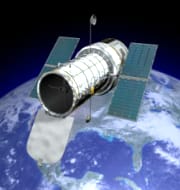Hubble Telescope spots solitary dwarf galaxy UGC 4879
NASA’s Hubble Space Telescope has uncovered a mysterious solitary dwarf galaxy known as UGC 4879.
The galaxy is smaller and messier than its cosmic cousins and lacks the majestic swirl of a spiral or the coherence of an elliptical.
Key findings
- The galaxy UGC 4879 is very isolated and consists of a scattered drizzle of stars.
- It about 2.3 million light years away from its closest neighbour, Leo A which is about the same distance as that between our Milky Way and the Andromeda Galaxy.
- The galaxy has not interacted with any of surrounding galaxies that makes it an ideal laboratory for astronomers to study star formation by interactions with other galaxies.
- The scientific studies of this solitary galaxy UGC 4879 will provide ample scientific study material for astronomers looking to understand the complex mysteries of star birth throughout the universe.
- It will especially help astronomers to study amount of star formation in the first 4 billion years after the Big Bang and followed by a strange 9 billion-year lull in star formation.
About Hubble Space Telescope (HST)
- HST was launched in 1990 as an international cooperation space project between NASA and European Space Agency.
- It is managed by NASA’s Goddard Space Flight Center in Greenbelt, Maryland. Its science operations are conducted by Baltimore based Space Telescope Science Institute (STScI).
- It is located in low Earth orbit outside the distortion of Earth’s atmosphere that allows it to take extremely high-resolution images.
Month: Current Affairs - June, 2016


